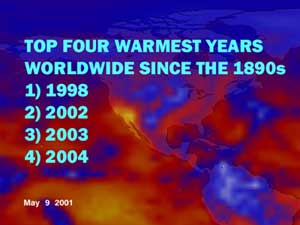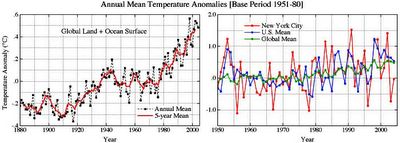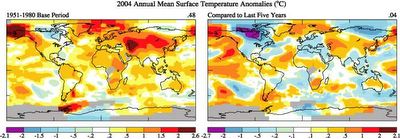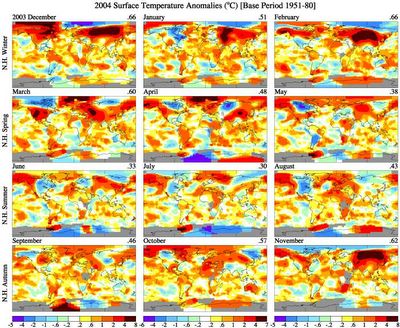
2004 was the fourth warmest year on average for our planet since the late 1800s, according to data released February 8, 2005 by NASA. However, that record may be surpassed by an even warmer 2005. Compared to the average temperatures from the 1951 to 1980 period, the largest unusually warm areas of 2004 were in Alaska, near the Caspian Sea, and over the Antarctic Peninsula. But compared to the previous five years, the United States as a whole was quite cool, particularly during the summer.

Globally, 1998 was warmest year on record, with 2002 and 2003 coming in second and third, respectively. "There has been a strong warming trend over the past 30 years, a trend that has been shown to be due primarily to increasing greenhouse gases in the atmosphere," said Dr. James E. Hansen, director of NASA's Goddard Institute for Space Studies. The main source of such gases is smokestack and tailpipe emissions from burning coal and oil.

Global temperatures vary from year to year and place to place, but weather stations and satellite data provide accurate records. By recording the temperatures over time, scientists have developed a record of the climate, and have been able to see how it's been changing.
Some of the changes in climate are due to short-term factors like large volcanic eruptions that launched tiny particles of sulfuric acid into the upper atmosphere (stratosphere) in 1963, 1982, and 1991. These natural events can change climate for periods of time ranging from months to a few years. Other natural events, like El Ninos, when warm water spreads over much of the tropical Pacific Ocean, also have large short-term influences on climate. The large spike in global temperature in 1998 was associated with one of the strongest El Ninos of recent centuries, and a weak El Nino contributed to the unusually high 2002-2003 global temperatures.
Even though big climate events like El Nino affect global temperatures, the increasing role of human-made pollutants plays a big part. Scientists, like Dr. Hansen, have been trying to predict how human impacts on climate will affect the annual world temperature trends in the future.

Dr. Hansen said Earth's surface now absorbs more of the Sun's energy than gets reflected back to space. That extra energy, together with the weak El Nino, is expected to make 2005 warmer than the years of 2003 and 2004 and perhaps even warmer than 1998, which had stood out as far hotter than any year in the preceding century.
The unusual nature of the recent warming was separately corroborated by a new analysis of 2,000 years of indirect temperature records in tree rings, stalagmites, seabed layers, and other evidence from around the Northern Hemisphere. That study, published in the journal Nature, found that previous peaks of warming, particularly during medieval times about 1,000 years ago, were as warm as the 20th-century average but that no spikes in the last 2,000 years matched the warming since 1990.
This is one of several recent studies challenging a longstanding view that temperatures in the Northern Hemisphere were relatively unvarying until the recent warming, a pattern enshrined in a graph scientists have taken to calling the hockey stick for its long horizontal "shaft" and upward-hooking "blade."
The lead author of the new paper, Anders Moberg of Stockholm University in Sweden, said it was important to recognize that natural influences on climate could either amplify or mask human-caused warming in years to come. But his paper "should not be a fuel for greenhouse skeptics in their arguments," Dr. Moberg said, adding that there were ample signs that the warming was now outside nature's recent bounds.

1 comment:
In related news, the Bush administration wants scientists to just make up crap about things related to Fish & Wildlife.
Post a Comment